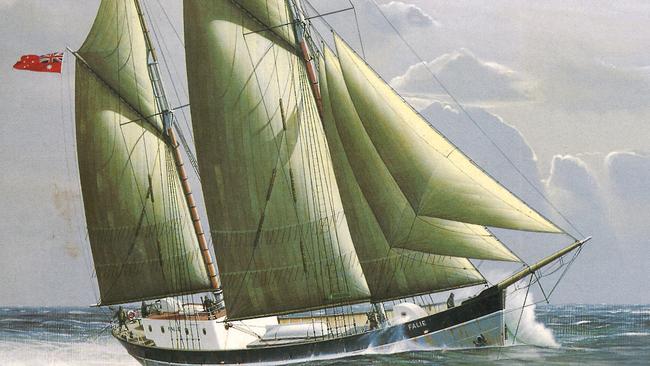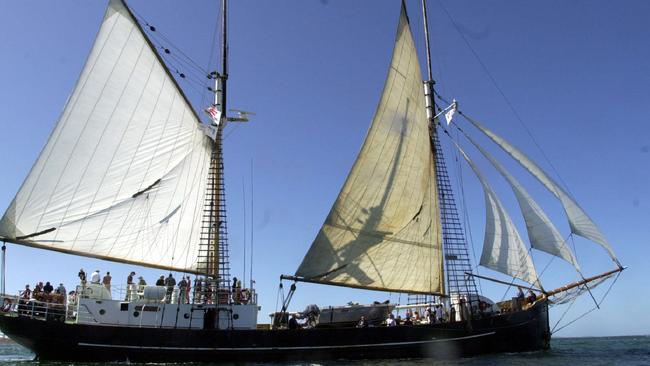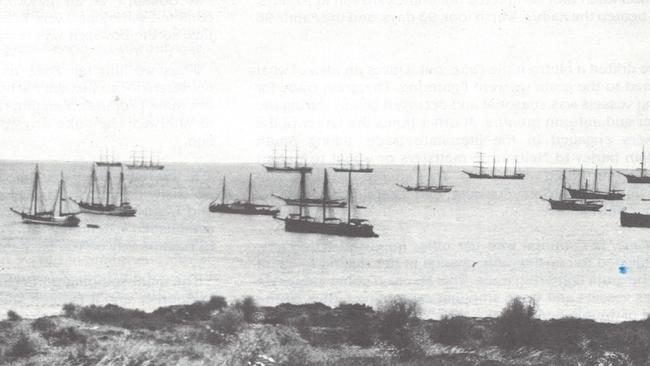A small dedicated band of volunteers keep the Falie afloat but they face lack of new faces and a sea of red tape
She was the last of the huge ketch fleet that drove our state, and went on to serve the country during WWII. The Falie helped keep SA afloat, and now we need to repay the favour. Nathan Davies reports.

THEY were the lifeblood of South Australia, a fleet of ketches that plied our ports from the South-East to the West Coast, delivering necessities to our outlying towns and transporting the grain and wool that drove the state’s economy.
In a time when road access from Adelaide to our regions was, at best, unreliable and, at worst, non-existent, the ketches were the road trains of their day. Even when the roads improved, South Australia’s unique shape, with three peninsulas and two large gulfs, meant that transportation by sea was often still the cheapest and most efficient method.
Up to 400 of these magnificent small ships worked the South Australian coastline, with perhaps 50 or 60 working at any one time.

Now they’re virtually all gone – sunk, scuttled, sold off or left to rot in fields. One floating ketch – the Falie – remains, a unique link to our seafaring past. Restored with great fanfare – and a fair chunk of taxpayers’ money – for the state’s 150th celebrations in 1986, this 46m steel-hulled ship not only served the state but also served the country during World War II.
Now she sits at the wharf in Port Adelaide, tied up next to the more glamorous but hardly historical tall ship replica the One and All.
A small but dedicated band of volunteers keep Falie afloat, but they’re facing a battle on two fronts – a lack of a new generation of volunteers and an increasing sea of Government red tape.
The situation came to head earlier this month when the Department of Planning, Transport and Infrastructure changed the locks on the vessels, barring access to the volunteers, who have ploughed thousands of man hours into the ship. A Fringe event which was to be held onboard was also cancelled. The department claimed the ship wasn’t meeting safety standards, but those involved with the Falie’s upkeep said changing the locks was an unnecessarily heavy-handed move. Access has now been restored after a number of meetings and work has begun to bring it up to DPTI standard, but the volunteers say the incident highlights how fragile this vital link with our past has become.

Volunteer Keith Ridgeway is part of a team of six workers who meet on board the Falie every Wednesday and Friday to keep the old girl shipshape. Mr Ridgeway said he was “disappointed” that the volunteers were locked out of the Falie and believes the situation could have been handled better.
He said that the increasing red tape that seems to accompany all aspects of modern life wasn’t the only threat to the boat’s future.
“We’re all in our seventies or late sixties now,” the lifelong seafarer said.
“It’s impossible to get young people to volunteer, they just don’t have the time. They’ve got work and footy and kids and all of that. We’re always looking for younger volunteers.”
Mr Ridgeway said keeping the Falie afloat was a big job, a battle against the elements.
“It’s a constant upkeep, as it always is with anything in salt water,” he said. “You’re constantly fighting rust, trying to keep everything clean.”
Mr Ridgeway said the Falie was our last link to an important chapter in the state’s history.
“You’re looking at a time when there were no roads to places like Port Lincoln and the ketches were the only way to get things in and out,” Mr Ridgeway said.
“Not just Port Lincoln but Smoky Bay, Streaky Bay, Venus Bay, Elliston – anywhere there was a jetty. The ketches might kget in at two in the morning, and the farmers would just leave bags of grain on the jetty for them. They’d load up and write down what they’d taken. They really were the trucks of their day.”

Mr Ridgeway said it was hard to over-estimate just how important the ketches were to our state.
“They’re an important South Australian story,” he said. “South Australia was built by these ketches.”
Mr Ridgeway said without major restoration work, the Falie would have to be put into hardstand storage at the SA Martime Museum within a few years.
Transport and Infrastructure Minister Stephen Mullighan said that, while it was true the volunteers were locked out of the ship, the Falie remained important to the Government.
“The Falie is an important part of the maritime heritage of Port Adelaide, and a key tourist attraction,” Mr Mullighan said.
“The Falie is looked after by longstanding volunteers who do an extraordinary job ...
“Access was temporarily restricted to the volunteers after the Department of Planning, Transport and Infrastructure discovered some unsafe wiring on the boat. Following a meeting between the local MP Susan Close, the Chief Operating Officer of the department and myself, access has been resumed and works to fix the issue and make the Falie safe for volunteers and the public is being undertaken.”
In service of state and country
■ Built in 1919 in the town of Maassluis, the Netherlands, the Falie was originally named Hollands Trouw.
■ Hollands Trouw was purchased by the Spencer’s Gulf Transport Company in 1922, and sailed to South Australia in 1923.
■ The vessel was renamed after Captain Andreas Broun’s wife Philomena, who was better known as Falie.
■ Falie spent years servicing the farm ports of South Australia, delivering vital supplies to outlying towns and transporting grain from the farms.
■ During WWII, Falie was requisitioned by the Royal Australian Navy. On the night of May 31, 1942, the vessel was stationed at the entrance to Sydney Harbour and grazed one of the three Japanese midget submarines sent to attack the city. A report was made, but not followed up by authorities. The submarine – M24 – went on to sink HMAS Kuttabul, killing 21 sailors. Falie was later used to ferry troops to New Guinea.
■ After the war, Falie spent some time transporting explosives around the Australian coast before returning to South Australia in 1968. It continued to work as a transport vessel right up until 1982. It was the last ketch to operate in South Australian waters. She is also believed to have been the last cargo vessel in Australia to carry working sails.
■ Falie was purchased by the SA Government, at a cost of $180,000, for the State’s sesquicentenary celebrations in 1986. She was extensively restored.
■ She was used as a sail training vessel for young sailors hoping to join the Merchant Navy, as well as a charter vessel for fishing and shark diving trips.
■ A 2005 survey found Falie to be unseaworthy, and she now sits at the wharf in Port Adelaide.
